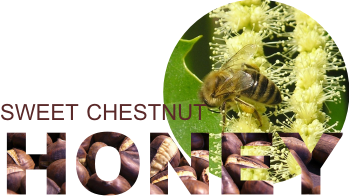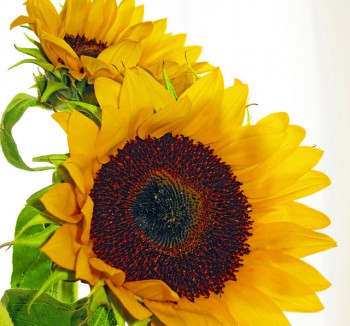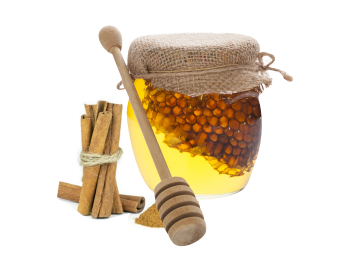The chestnut tree:
The chestnut tree is a Castanea genus, native to temperate regions of the Northern Hemisphere. The name also refers to the edible, tasty nuts they produce. Chestnuts belong to the same family as the oak and beech.
There are 4 main species: European, Asiatic (Chinese and Japanese) and American chestnuts.
• European species: Sweet Chestnut (Castanea sativa) known as “Spanish chestnut” in the US, is the only European species of chestnut. It was successfully introduced to the Himalayas and other temperate parts of Asia.
• Asiatic species: there are several species here: C. renata , C. mollissima, C. davidii, C. henryi, C. seguinii.
• American species: These include C. dentata (American chestnut – Eastern states), C. pumila (American- or Allegheny chinkapin, also known as “dwarf chestnut” – Eastern states), C. alnifolia (Southern states), C. ashei (Southern states), C. floridana (Southern states) and C. paupispina (Southern states).

Chestnuts can be easily confused with some other tree they resemble with, like:
· horse chestnuts (genus Aesculus), NOT related to Castanea, but which makes very similar nuts. Yet, these are mildly poisonous to humans.
· water chestnut (family Cyperaceae), NOT related to Castanea, and are tubers of similar taste from an aquatic herbaceous plant.
· chestnut oak (Quercus prinus), in China.
· American beech (Fagus grandifolia).
Honey is made from the following species of castanea:
– Sweet Chestnut (Castanea sativa) found mainly in Europe;
– Allegheny Chinkapin (C. pumila) grown in Eastern USA produces a strong and bitter honey;
– Japanese Chestnut (C. crenata) growing mainly in S. Korea;
– Chinese Chestnut (C. mollissima), Henry Chinkapin (C. Henryi), Sequin (C. Seguiniii) all grown in China may be sources of honey.
 The nuts:
The nuts:
The tree’s fruits, the nuts, are different from the other nuts we know. They are:
– very rich in potassium, phosphorus, magnesium, chloride, calcium, iron and sodium minerals.
– contain vitamins: C, B1, B2, B6, E and PP.
– very little protein or fat, their calories coming chiefly from carbohydrates. Fresh chestnut fruits have about 180 calories (800 kJ) per 100 grams of edible parts, which is much lower than walnuts, almonds, other nuts and dried fruit (about 600 kcal/100 g).
– the carbohydrate content is the same as of wheat and rice
– no cholesterol
– very little fat, mostly unsaturated
– no gluten
– twice as much starch as the potato
– various sugars, mainly sucrose, glucose, fructose (8%)
– contain 40 mg vitamin C per 100 g of raw product, but it decreases by 40 percent after heating. Chestnuts are the only nuts with Vit. C!
The fruit can be peeled and eaten raw, though it is a little astringent, especially if the pellicle is not removed. But it tastes incredible when it’s roasted. Roasting requires scoring the fruit beforehand to prevent explosion of the fruit due to expansion. Once cooked, its texture is slightly similar to that of a baked potato, with a delicate, sweet, and nutty flavor. Yummy!
Chestnut honey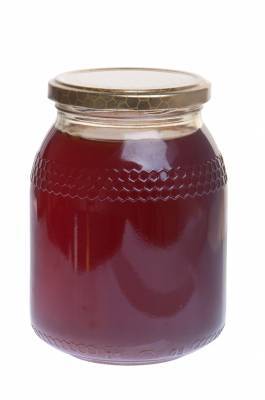
Sensory description:
Color intensity: dark to very dark
Color tone: normal honey color with reddish tone
Aroma: woody, chemical, warm and spoiled
Intensity of aroma: strong
Persistence/aftertaste: long
Other mouth perceptions: astringent
Intensity of odor: strong
Sweetness: weak (Bitter honeys like linden and sweet chestnut seem less sweet than honeys with weak taste like acacia.)
Bitterness: strong. (The bitter taste is characteristic for sweet chestnut and linden honeys, and is a special characteristics of the world´s most bitter honey, harvested in Italy from Arbutus.)
Acidity: weak
Crystallization rate: slow. Due to the high fructose and low glucose content, this type of honey remains for a long time in a liquid state.
Water content: high (it gives a fluid consistency)
Electrical conductivity: above 0.8 mS/cm (like arbutus, erica, eucalyptus and linden honeys)
Fructose content: high, around 40% (like acacia, tupelo, thyme, calluna)
Glocose content: low 27%
GI: low, between 49 and 55
pH: relatively high value of 5 to 6. (Honeydew honeys, due to their higher mineral content, have a higher pH value, varying between 4.5 and 6.5.)
Chestnut honey has quite a typical physicochemical pattern, with low values of Glucose/Water ratio and high values of color, electric conductivity, enzymes, pH and Fructose/Glucose ratio.
Prebiotic activity of chestnut honey: not very high, yet higher than that of acacia honey. (Lucan et al., 2009).
Antibacterial potency, type of antibacterial activity: average to high, both peroxide and non-peroxide
Antioxidant power: especially high (like buckwheat, honeydew, manuka, tualang, ceratonia)
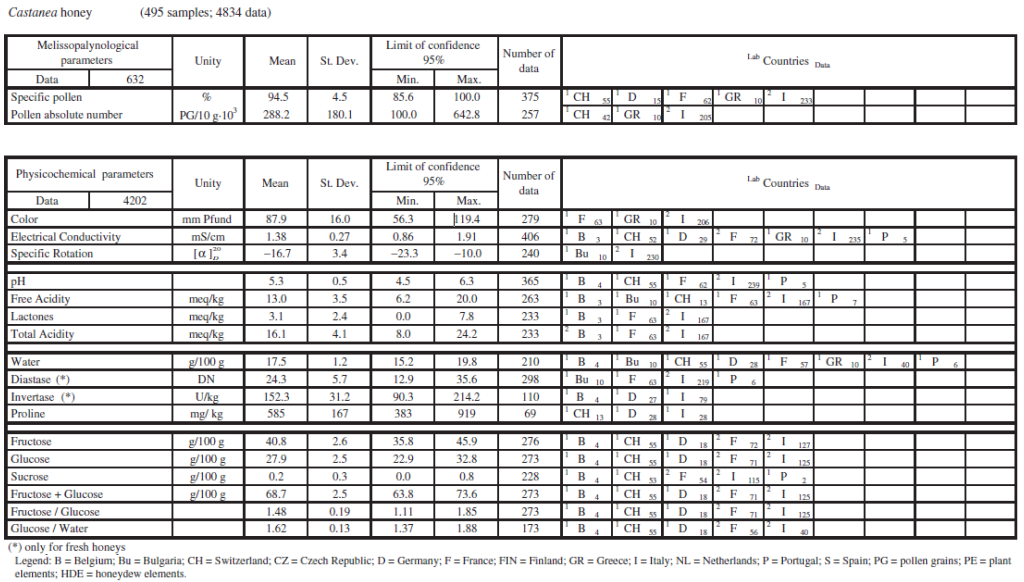 Labs classify chestnut honey as blossom honey in a 84 % of them, while the rest is considered to be honeydew honey. The tree is indeed a very good source for nectar and pollen, but it also provides a lot of honeydew, due to the attack of some insects like: Rhynchota Homoptera: Lachnus roboris L. (Lachnidae), Myzocallis castanicola (Baker) (Callaphididae), Parthenolecanium rufulum (Cockrell) (Coccidae). The honey bees also collect the honeydew these insects leave behind on the tree’s bark.
Labs classify chestnut honey as blossom honey in a 84 % of them, while the rest is considered to be honeydew honey. The tree is indeed a very good source for nectar and pollen, but it also provides a lot of honeydew, due to the attack of some insects like: Rhynchota Homoptera: Lachnus roboris L. (Lachnidae), Myzocallis castanicola (Baker) (Callaphididae), Parthenolecanium rufulum (Cockrell) (Coccidae). The honey bees also collect the honeydew these insects leave behind on the tree’s bark.
The picture shows the values of chestnut honey composition, as published in the study “Main European unifloral honeys: descriptive sheets” by Livia PERSANO ODDO et al.
Chestnut honey benefits:
It has a high antimicrobial activity
Undetermined components of the water and methanolic extract of chestnut honey inhibit pathogenic bacteria like Erwinia carotovora, Yersinia enterocolitica, and Aeromonas hydrophila interfering in the quorum signal (QS) system of bacteria. The bacterial QS system is thought to determine the virulence of bacteria. The substances are thought to belong to the carbohydrate fraction of honey¹.

It is excellent with aged cheeses (Stracchino, Ricotta) or hearty meat dishes. Or try it the Tuscan way: drizzled over a piece of Pecorino Toscano with some fresh pears.
It reduces pain
The antinociceptive (pain-soothing) is thought to be triggered by quinoline alkaloids. These quinoline alkaloids are present in exceptionally high concentration in chestnut honey, while they were present in much lesser quantitities in honeydew, acacia, thyme, lavender, dandelion, sulla, thymus, sunflower and linden honeys.²
It has imunostimulating effects
Apalbumine 1, the dominant royal jelly in honey with immunostimulating properties, is present in unifloforal honeys in different quantities. Chestnut honey has the highest quantity of apalbumine. This decreases in the following order: Chestnut > Dandelion > Rape, Linden, Acacia.
It has gastroprotective properties
The content of nitrate (NO3) in honey is thought to be the causative action of the gastroprotective action of honey. Dark honeys like honeydew and sweet chestnut had considerably higher concentration than light honeys (acacia, orange blossom, lavender, sunflower, arbutus)².
Improves blood circulation
Like all dark and strong honeys, chestnut honey improves blood circulation and to lower the blood pressure;
It is useful against anemia
It is helpful in infections of kidney urinary bladder.³
Pollen is a remarkable source of antioxidants, with excellent results in balancing the nervous system, anemia demineralization. A very good combination is made from sweet chestnut and blackberry pollen.
Other therapeutical folk claims:
It is good against the prostate complaints.
It strengthens the blood vessels.
It prevents the formation of varicose veins and hemorrhoids.
It strengthens the nerves.
It is good for liver fatigue and swelling.
It strengthens the stomach.
It heals anemia.
It is beneficial for physical and mental fatigue.
It also strengthens the muscles.
In Southern Spain, up in the mountains above San Pedro de Alcantara, there is a famous chestnut called “Castaño Santo”, meaning the Sacred Chestnut of Istan, referred to as the Grandfather of the Forest.
People say it is 800-1000 years old! Its trunk is 14 meters around.

References:
¹ TRUCHADO, P; GIL-IZQUIERDO, A; TOMAS-BARBERAN, F; ALLENDE, A (2009) Inhibition by
Chestnut Honey of N-Acyl-L-homoserine Lactones and Biofilm Formation in Erwinia carotovora,
Yersinia enterocolitica, and Aeromonas hydrophila. Journal of agricultural and food chemistry 57
(23): 11186-11193.
² BERETTA, G; VISTOLI, G; CANEVA, E; ANSELMI, C; FACINO, R M (2009) Structure elucidation and
NMR assignments of two new pyrrolidinyl quinoline alkaloids from chestnut honey. Magnetic
resonance in Chemistry 47 (5): 456-459.
³ BOGDANOV, S; GALLMANN, P; STANGACIU, S; CHERBULIEZ, T (2006) Bienenprodukte und
Gesundheit. AlpForum 41: 3-50.
CLASSIFICATION OF HONEYDEW AND BLOSSOM HONEYS BY DISCRIMINANT ANALYSIS, ALP science 2006, Nr. 500
“Main European unifloral honeys: descriptive sheets” by Livia PERSANO ODDO et al., published by Apidologie 35 (2004) S38–S81 © INRA/DIB-AGIB/ EDP Sciences, 2004.
The honey book, Stefan Bogdanov, February 2014
CURATIVE MELLIFEROUS PLANTS IN TURKEY, by Orhan Kosi, Ankara, Turkey
Picture credit:
“Castano santo” picture credit tree-species, via flickr.com, published under CC;
“Chestnut flowers”picture credit Maja Dumat, via flickr.com, published under CC;
“Roasted chestnuts” – cropped picture of Lars Tinner, published under CC via flickr.com
“jar of honey” picture credit artur84 via freedigitalphotos.net

